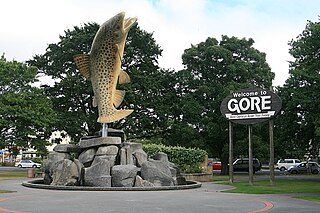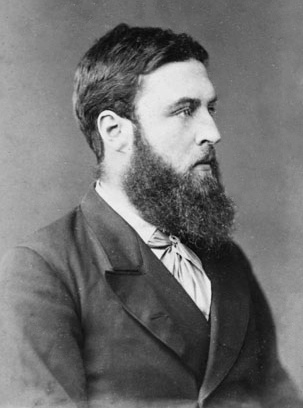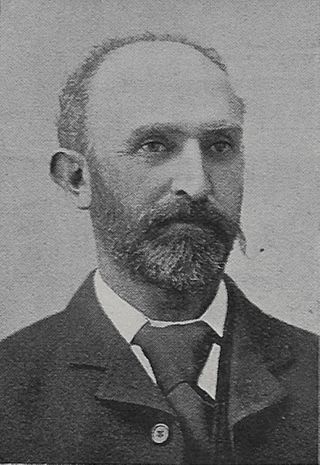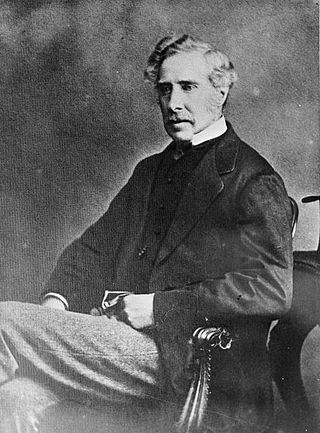
Gore is a town and district in the Southland region of the South Island of New Zealand. It has a resident population of 8,240 as of June 2023. Gore is known for its country music scene and hosts an annual country music festival. The town is also surrounded by farmland and is an important centre for agriculture in the region.

The 1879 New Zealand general election was held between 28 August and 15 September 1879 to elect a total of 88 MPs to the 7th session of the New Zealand Parliament. The Māori vote was held on 8 September. A total of 82,271 (66.5%) European voters turned out to vote, plus 14,553 Māori voters. Following the election, John Hall formed a new government.

The 1896 New Zealand general election was held on Wednesday, 4 December in the general electorates, and on Thursday, 19 December in the Māori electorates to elect a total of 74 MPs to the 13th session of the New Zealand Parliament. A total number of 337,024 (76.1%) voters turned out to vote.

The 1899 New Zealand general election was held on 6 and 19 December in the European and Māori electorates, respectively, to elect 74 MPs to the 14th session of the New Zealand Parliament. The election was again won by the Liberal Party, and Richard Seddon remained Prime Minister.

John Cathcart Wason, generally known as Cathcart Wason, was a Scottish farmer and politician who served as a Member of Parliament in two countries: first in New Zealand and then in Scotland. He established Barrhill, a model village, and after the failure of this colonial venture, he returned to Scotland. An unusually large man, he is noted both as an innovative farmer and for having passed his time in the British House of Commons by knitting.

Nelson is a New Zealand parliamentary electorate, returning one Member of Parliament to the House of Representatives of New Zealand. From 1853 to 1860, the electorate was called Town of Nelson. From 1860 to 1881, it was City of Nelson. The electorate is the only one that has continuously existed since the 1st Parliament in 1853.

Eden, a former New Zealand parliamentary electorate, lay in the general area of the suburb of Mount Eden in the city of Auckland.
Awarua was a New Zealand parliamentary electorate from 1881 to 1996.
Wallace was a New Zealand parliamentary electorate. It was established in 1858, the first election held in 1859, and existed until 1996. From 1861 to 66, it was represented by two members. In total, there were 18 Members of Parliament from the Wallace electorate.
The former New Zealand parliamentary electorate on the western inner city of Auckland, was known as City of Auckland West from 1861 to 1890, and then Auckland West from 1905 to 1946.
Thames is a former New Zealand electorate, in the Thames-Coromandel District. It existed from 1871 to 1946.
Mataura was a parliamentary electorate in the Southland Region of New Zealand, from 1866 to 1946.
James Mackintosh was a 19th-century Liberal Party Member of Parliament in Southland, New Zealand.

Thomas Shailer Weston, often referred to as Thomas S. Weston, was a judge and 19th-century Member of Parliament from Westland, New Zealand. Weston was the patriarch of one of two dominant Canterbury families of the legal profession.

Seymour Thorne George was a New Zealand politician. The premier, Sir George Grey, was his wife's half-uncle and adoptive father, and that relationship resulted in Thorne George representing the South Island electorate of Hokitika despite him being based in the North Island. He later represented the Rodney electorate. Thorne George was later Mayor of Parnell.
James Steuart Shanks was a 19th-century Member of Parliament from the Southland region, New Zealand.

The 13th New Zealand Parliament was a term of the New Zealand Parliament. It was elected at the 1896 general election in December of that year.

The 14th New Zealand Parliament was a term of the New Zealand Parliament. It was elected at the 1899 general election in December of that year.

This is a summary of the electoral history of Sir George Grey, Prime Minister of New Zealand, (1877–1879). He represented six electorates during his political career.
The 1878 Waipa by-election was a by-election held on 24 July 1878 during the 6th New Zealand Parliament in the electorate of Waipa in the Waikato.
This page is based on this
Wikipedia article Text is available under the
CC BY-SA 4.0 license; additional terms may apply.
Images, videos and audio are available under their respective licenses.









